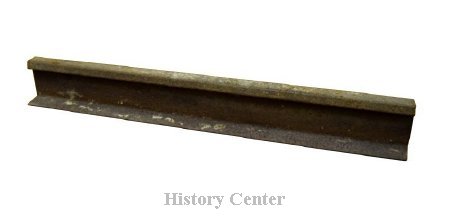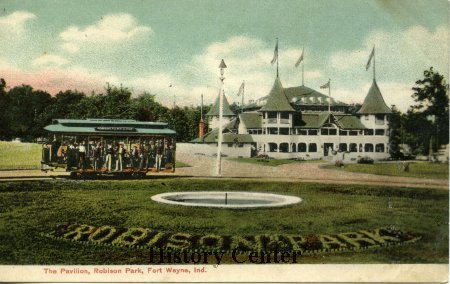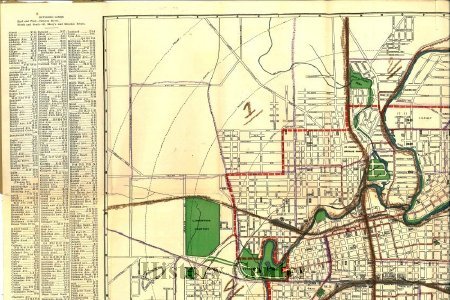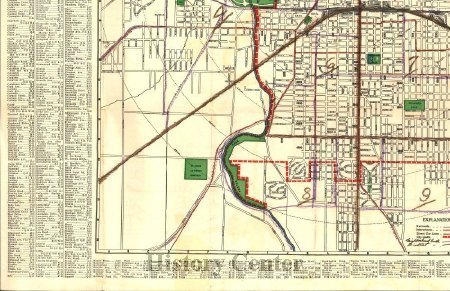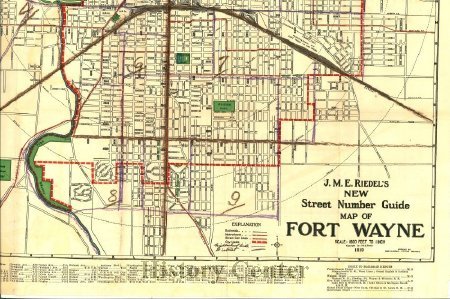Date:
c. 1897-1918
Title:
Robison Park Rail
Description:
It was reported that 8,000 people attended the public opening of Robison Park on 13 Jun 1896 and more came to the "Grand Opening" on the following 4th of July. The park was in a rural setting seven miles north of Fort Wayne along the St. Joseph River Wayne with lagoons for boating, landscaped picnic areas, and walkways for leisurely strolls. The impressive 110 by 125 foot three-story pavilion was the first major attraction at the site, a place to buy refreshments, socialize, dance and gather for scheduled events. Guests inside and those walking the grounds were entertained with waves of band music pumped from the "Orchestrion" installed in the building. Other attractions were added over the years such as Trier's Dance Hall, amusement rides, a zoo, water slide, theater, bowling alley and a baseball field. In addition to these site attractions the public was enticed to the park by special shows and performances. For individuals, families, and organized groups it was a popular summer venue for socializing and entertain-ment for twenty-three years.
The Fort Wayne Consolidated Railway Company conceived the park as a way to increase its revenue by charging fares for the seven-mile trip to the park, an extension of its trolley lines serving the city of Fort Wayne. The 48-1/2 -inch rail section was salvaged from the park grounds, part of the double-track line from transfer corner (Main and Calhoun Streets) to the park constructed by the M. J. Degnon Construction Company of Cleveland, Ohio. In the late 1890s, twenty-five summer trolleys with open sides (or curtained as needed) were available to transport up to 1,200 people each hour if necessary. A round-trip fare was twenty cents. Revenue from riders was never very profitable and trolley and park maintenance costs increased over the years. These realities were exacerbated by visitors traveling to the park by buggy or automobile, up to twenty percent in 1919. Although it had a successful season in 1919 it would be its last-fees from the 197,000 passengers who used the rail line that year were not enough to keep up with expenses. Robison Park did not reopen in 1920. The Fort Wayne and Northern Indiana Traction, who owned the line in 1919, were forced into foreclose and its assets were sold to the Indiana Service Corporation.
The Robison park line preceded the more extensive use of Interurban electric railway systems that followed in the early 1900s. In fact the Fort Wayne Traction Company, who owned the line at the time, became part of a combine established in February 1904 that provided transportation between towns in central Indiana and connections east to Ohio. It created a dependable link between town and country, in-creasing the mobility of people for business, shopping, work and recreation. The Interurban rail service was eventually discontinued in 1941 giving way to new forms of transportation.
The Fort Wayne Consolidated Railway Company conceived the park as a way to increase its revenue by charging fares for the seven-mile trip to the park, an extension of its trolley lines serving the city of Fort Wayne. The 48-1/2 -inch rail section was salvaged from the park grounds, part of the double-track line from transfer corner (Main and Calhoun Streets) to the park constructed by the M. J. Degnon Construction Company of Cleveland, Ohio. In the late 1890s, twenty-five summer trolleys with open sides (or curtained as needed) were available to transport up to 1,200 people each hour if necessary. A round-trip fare was twenty cents. Revenue from riders was never very profitable and trolley and park maintenance costs increased over the years. These realities were exacerbated by visitors traveling to the park by buggy or automobile, up to twenty percent in 1919. Although it had a successful season in 1919 it would be its last-fees from the 197,000 passengers who used the rail line that year were not enough to keep up with expenses. Robison Park did not reopen in 1920. The Fort Wayne and Northern Indiana Traction, who owned the line in 1919, were forced into foreclose and its assets were sold to the Indiana Service Corporation.
The Robison park line preceded the more extensive use of Interurban electric railway systems that followed in the early 1900s. In fact the Fort Wayne Traction Company, who owned the line at the time, became part of a combine established in February 1904 that provided transportation between towns in central Indiana and connections east to Ohio. It created a dependable link between town and country, in-creasing the mobility of people for business, shopping, work and recreation. The Interurban rail service was eventually discontinued in 1941 giving way to new forms of transportation.
Click to Enlarge

